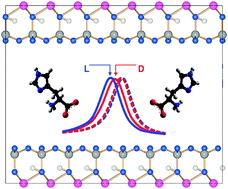Chiral interactions of histidine in a hydrated vermiculite clay†
Abstract
Recent work shows a correlation between chiral asymmetry in non-terrestrial

- This article is part of the themed collection: Homochirality and the origin of life
Maintenance work is planned for Wednesday 1st May 2024 from 9:00am to 11:00am (BST).
During this time, the performance of our website may be affected - searches may run slowly and some pages may be temporarily unavailable. If this happens, please try refreshing your web browser or try waiting two to three minutes before trying again.
We apologise for any inconvenience this might cause and thank you for your patience.
* Corresponding authors
a
Department of Earth Sciences, University of Oxford, Parks Road, Oxford OX1 3PR, UK
E-mail:
don@earth.ox.ac.uk
b Department of Chemistry, Durham University, South Road, Durham DH1 3LE, UK
c Department of Physics & Astronomy, University College London, Gower Street, London WC1E 6BT, UK
d Department of Physics, University of York, Heslington, York YO10 5DD, UK
e Institut Laue Langevin, F-38042 Grenoble, Cedex 9, France
f ISIS Facility, Rutherford Appleton Lab, HSIC, R3 1-22, Didcot, UK
Recent work shows a correlation between chiral asymmetry in non-terrestrial

 Please wait while we load your content...
Something went wrong. Try again?
Please wait while we load your content...
Something went wrong. Try again?
D. G. Fraser, H. C. Greenwell, N. T. Skipper, M. V. Smalley, M. A. Wilkinson, B. Demé and R. K. Heenan, Phys. Chem. Chem. Phys., 2011, 13, 825 DOI: 10.1039/C0CP01387K
To request permission to reproduce material from this article, please go to the Copyright Clearance Center request page.
If you are an author contributing to an RSC publication, you do not need to request permission provided correct acknowledgement is given.
If you are the author of this article, you do not need to request permission to reproduce figures and diagrams provided correct acknowledgement is given. If you want to reproduce the whole article in a third-party publication (excluding your thesis/dissertation for which permission is not required) please go to the Copyright Clearance Center request page.
Read more about how to correctly acknowledge RSC content.
 Fetching data from CrossRef.
Fetching data from CrossRef.
This may take some time to load.
Loading related content
